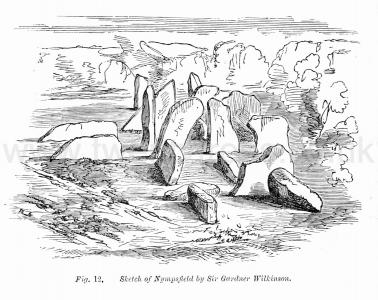Nympsfield
Nympsfield is in Proceedings of the Cotteswold Naturalists' Field Club Volume 3.
Notes on an Ancient British Tumulus at Nympsfield [Map], opened by the Cotteswold Club. By James Buckman, F.G.S., F.L.S., F.S.A., &c., Professor of Botany and Geology.
The Barrow at Nympsfield, which was opened by the members of the Cotteswold Club in August, 1862, presents so many points of interest that I venture to lay before you a short description of our proceedings, to which, through the kindness of Dr. Thurnam, I am enabled to add some valuable Notes on some of the skulls which were submitted to his examination.
The Tumulus is situated on an eminence known as Crawley Hill, at a distance of about half a mile to the north of that of Uley, which latter was opened in the year 1821, and re-opened in 1854, under the direction of Mr. E. A. FREEMAN and Dr. Thurnam.1
Note 1. See the full description of the Uley Tumulus by J. Thurnam, M.D., F.S.A., in the Archæological Journal, Vol. xi., p. 313.
The Nympsfield Tumulus appears to have been opened on a former occasion, so that on being re-opened, it was presented to the Club in a much less perfect condition than that near Uley-Bury, if indeed, it was ever quite so complete; still the plan of the two is so exactly identical, that there can be little doubt but that both were the work of the same period and people. The following sketch of the former is by Sir Gardner Wilkinson.
The Tumulus in both is of an ovoid form, and in each the broad end where the chamber was situated, is to the east, and the small one to the west; the one near Uley-Bury, which is 120 feet in length, and 85 feet in its greatest breadth, being a few feet longer than that at Nympsfield.
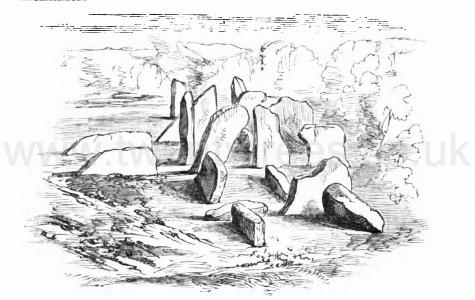
On exposing the chambers in the Nympsfield Tumulus, it was at once seen that the upright stones marked more or less perfectly a central passage with one or perhaps a double set of cruciform or lateral chambers on either side; in the first of which on the north side was partitioned off a smaller chamber or cist, probably to receive some infantile remains, as such were found therein. (See Ground Plan, b´.)
In certain parts, the spaces between the uprights and the walls of the entrance were made up of dry walling, as shown on the plan.
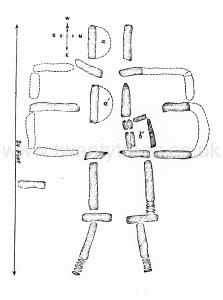
So far then this is almost identical with the plan of the chambers at Uley, but the latter will be found to have fine slabs of stone placed roof wise on the tops of the upright stones; a feature, which if ever present at Nympsfield, as probable, must have been destroyed at some previous opening.
In both cases the work appears to have been commenced on the surface of the hill, with probably only just a sufficient trench to enable each. stone to be kept upright. Both hills offer examples of the upper beds of the Inferior Oolite; but in both cases, the stones used in constructing the chambers consist of the lower freestones of the Great Oolite, which, in all probability were quarried for the purpose at a distance of about half a mile to the north-east of the Nympsfield Tumulus, at a place called " Stone Hill. " These stones had but little, if any, fashioning, but their plank-like slabs varied to sizes of, for the uprights, 5 feet square to 1 foot thick; for the roofing slabs at Uley, 6 or 7 feet square.
It would appear that when the chambers were completed, and the bodies placed in them, a stone roof was placed over the whole, and then that the loose stones, earth, etc., were piled upon and over the whole, so as to form the tumulus; this method necessitating the construction of a slight fosse, which is observable surrounding the tumulus, especially in that of Uley.
In the Nympsfield one this fosse is not so observable, probably from the field having been for so long under the plough. Here, too, there was a deep depression in the top of the mound, most likely left after the former opening.
The contents of the Nympsfield chambers, comprise
I. Human bones; a few of which had been burnt.
II. Bones of Inferior or Domestic Animals.
III. A small fragment or two of Pottery.
IV. A few flakes of Flint.
I. As regards the human remains, it was deduced from thirty-twofemora, which were counted by Dr. BIRD, that the chambers, in the state in which the Club examined them, presented evidences of the remains of at least sixteen human bodies.
These varied in size and in age from very old to young men and women, with a few remnants of the bones of children; so that whatever may be true as regards other Tumuli of this period having been erected in honour of a chieftain, here it seems quite certain that we have the remains of a family or a tribe.
Portions of as many as ten or twelve skulls were sent to Dr. Thurnam, and his report upon them will follow this paper. It may not, how ever, be out of place here to mention that his observation of "a greater number of the teeth, namely two or three incisors and two or three molars, have been lost during life in the case of the most perfect of the Nympsfield skulls than in almost any other British skull he has examined,"1 is curiously confirmed as to the rough usage some at least of the occupants of these chambers must have received, by the finding of a portion of a rib whose overlapping ends proclaimed a former fracture. "Two vertebræ were anchylosed," says Dr. Payne, of Stroud.
Note 1. I do not suppose the teeth have been knocked out, but lost fromcaries, abscess, or other disease. (J.T.)
II. The Bones and Teeth of inferior animals comprised not a few remnants of the Ox, Hog, Dog, and Birds. Some, at least, of these creatures were the undoubted food of the ancient Britons; and it is conjectured, from the want of horizontality in the worn down human teeth, that animal food was indeed their chief subsistence.
III. The small fragment of Pottery is of the usual brownish or black unbaked clay of the period. This fragment is scored with the peculiar impressed marks so common in ancient British fictilia. It is curious that only two small bits of Pottery should have been found. Is this to be attributed to such matters having been taken away at the former exhumation? In the Tumuli of Wiltshire, when they have not been rifled, some very fine urns often occur. Some of these are now to be seen in the possession of Mr. CUNNINGTON, of Devizes, whose grandfather, in conjunction with Sir R. C. Hoare, opened so many barrows in the rich archaic county of Wilts.
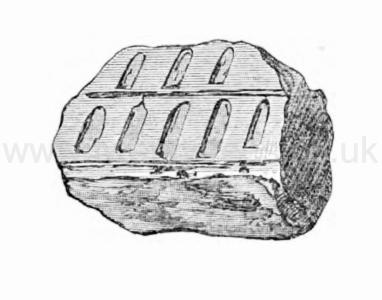
IV. The Flint flakes, though in themselves so insignificant, are yet important to observe, as Nympsfield is quite out of the way of the Flint drifts; and again, rude as are our specimens, I have no doubt that they got their present form by artificial means, and are either flakes chipped off in making more important implements; or were themselves designed to be completed for arrow-heads, rude knives or the like, or even used as such in their present form.
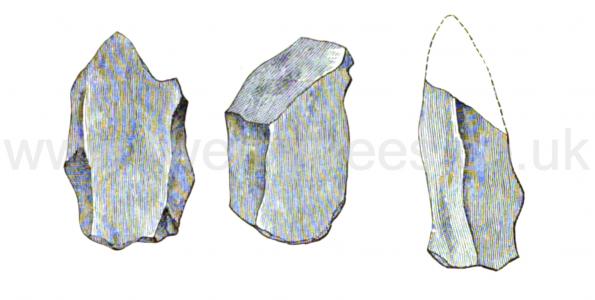
Sir Richard Hoare, in speaking of the Barrows of North Wilts, which I think were intimately connected with our Cotteswold examples, says that he found in them "no costly ornaments of jet, amber, or gold," such as "so often had rewarded his labours in the southern district of the county," and he hence draws an inference as to the "very high antiquity" of the Tumuli near Avebury, and also as to the "poverty" of the clan of Britons who inhabited these downs.1
Both North Wilts and this Hill-district of Gloucestershire were peopled by the Dobuni; and as Dr. Thurnam attributes the skulls from Uley, and some from West Kennet, in North Wilts2, to a very early pre-Roman period, we may probably assign to the same period the remains I have been describing.
Note 1. Quoted from a Paper on the Barrows of North Wilts, by Dr. Thurnam, in the Wilts Archæological and Natural History Magazine, 1860, vol. vi., p. 317.
Note 2. The West Kennet Chambered Barrow and Skulls are described in The Archæologia, vol xxxviii., p. 405; and in Crania Britannica, Decade V. pl. 50
Description of the Chambered Tumuli of Uley and Nympsfield. Nympsfield. — The Nympsfield Tumulus is situate on Crawley Hill, about half a mile north of that at Uley, above described. It was opened by the members of the Cotteswold Field Club in 1862, when it appeared to have been previously opened and the stones of which it was composed displaced, from which circumstance the plan was not so perfect as to prove its exact identity with that at Uley, although, as Professor Buckman states in his description of it2,there can be little doubt that both were the work of the same period and people." The view (fig. 12,) is from a sketch by the late Sir Gardner Wilkinson.
Note 2. Proceedings of the Cotteswold Naturalists' Field Club, Vol. III., p. 184.
